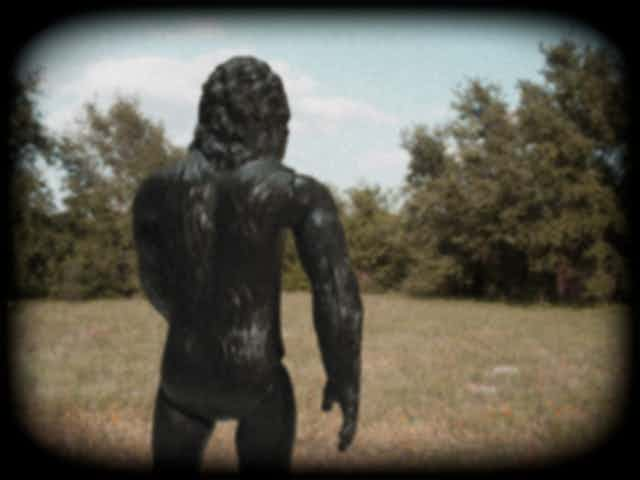Forget blurry pictures and casts of big foot-prints. A Texas veterinarian, Dr Melba Ketchum, and her collaborators have published an article, in a peer-reviewed scientific journal, proving the existence of Bigfoot.
It’s not the first peer-reviewed Bigfoot DNA paper. In 2004 an international team of geneticists, led by Michel Milinkovitch, published an analysis of “clearly identified … [yeti] hair”. They concluded the yeti, though genetically closer to ungulates, looks remarkably similar to primates.

A similar tongue-in-cheek paper, authored by Dave Coltman and Corey Davis from the University of Alberta, was published in a 2006 issue of TRENDS in Ecology and Evolution. And similar to the Milinkovitch paper the identification of the sample was not in question:
In July 2005, nine residents of Teslin, Yukon, witnessed through a kitchen window a large bipedal animal moving through the brush. The next morning, they collected a tuft of coarse, dark hair and also observed a footprint measuring 43 cm in length and 11.5 cm in width.
Coltman and Davis concluded that though Bigfoot, from eyewitness accounts, looked like Harry Henderson, genetically it was more closely related to bison. Of course, there is another explanation – the eyewitness account could have been wrong.

The problem with Ketchum’s paper? It’s not tongue-in-cheek. The authors are claiming to have sequenced not one but three Bigfoot genomes, concluding Bigfoot is a human hybrid. They even include HD footage of a sleeping Bigfoot (see below):
As you might guess, I’m not convinced. Why?
With such a claim having gone through the peer-review process you would expect the paper to appear in Science or Nature.
When the remains of the saola, a large deer looking mammal, were discovered in the early 1990s it resulted in a paper in Nature. Similarly, when an African monkey (kapunji) representing the first new genus of primate to be discovered since 1923 was discovered in 2003, an article in Science was the result.
So where was Ketchum’s paper published? “Denovo – Accelerating Science”. You shouldn’t be ashamed if you haven’t heard of it; after all, it was only registered in early February 2013, to none other than … Dr Melba Ketchum.
I guess there is nothing inherently wrong with someone publishing in a journal they own. Ketchum claims that she had to go down this route because of scientific bias. On her Facebook page Ketchum states:
Trying to publish has taken almost two years. It seems mainstream science just can’t seem to tolerate something controversial, especially from a group of primarily forensic scientists and not “famous academians” aligned with large universities … So, rather than spend another five years just trying to find a journal to publish and hoping that decent, open-minded reviewers would be chosen, we acquired the rights to this journal and renamed it.
Science is done by humans, so obviously there is an element of politics and ego in the science world, but as Dr. Lee Smolin articulated so well in the 2011 Isaac Asimov Memorial Debate:
Science isn’t about what is true or what might be true, science is about what people with originally diverse viewpoints can be forced to believe by the weight of public evidence.
And there is the problem in all this – the evidence does not look good.
Still, every cloud, silver lining, and all that.
I recently read Paul Willis’ article defending pseudoscience and couldn’t help but agree. I have always been interested in pseudoscience.
As a kid, I would consume books on unexplained mysteries. It didn’t matter what was in them. Bigfoot, aliens, ghosts, spontaneous human combustion – these were just mysteries waiting to be solved.
And this wasn’t to the exclusion of “real” science. “Unexplained mysteries” sat next to other books on space travel and dinosaurs. I even had a pictorial magazine on the female human anatomy (secretly stashed under my bed).

But as a communicator and scientist, my interest in paranormal phenomena has changed. When I hear extraordinary stories now, rather than scoff or attempt to debunk them, they are invitations to start talking about science.
It’s like the Bat-Signal for me.
If you start talking to me about mermaids, I will tell you a story about whale and seal evolution. You have a claim about strange things in the sky; I have a story on high-altitude jet streams.
Communicators and scientists shouldn’t shun those making incredible claims. For the most part, if someone is claiming to have seen some weird creature, it is because they have experienced something and are just curious. Curiosity is intellectual capital, so use it.
Nevertheless, some people making claims of the extraordinary are deliberately being flexible with the truth.
With the latest Bigfoot paper, I have no idea what the motivation was. But we do have a great example to show the public how not to publish supposedly paradigm-shattering science.
The old adage is as pertinent as ever: extraordinary claims require extraordinary evidence.

